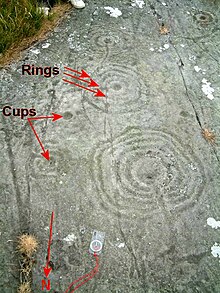
Cup and ring marks or cup marks are a form of prehistoric art found in the Atlantic seaboard of Europe (Ireland, Wales, Northern England, Scotland, France (Brittany), Portugal, and Spain (Galicia) – and in Mediterranean Europe – Italy (in Alpine valleys and Sardinia), Azerbaijan and Greece (Thessaly[citation needed] and Irakleia (Cyclades)[1]), as well as in Scandinavia (Denmark, Sweden, Norway and Finland)[citation needed] and in Switzerland (at Caschenna in Grisons).
Similar forms are also found throughout the world including Australia,[2] Gabon, Greece, Hawaii,[3] India (Daraki-Chattan and Dwarahat[4]), Israel, Mexico, Mozambique[5] and the Americas.[6][7] The oldest known forms are found from the Fertile Crescent to India.
They consist of a concave depression, no more than a few centimetres across, pecked into a rock surface and often surrounded by concentric circles also etched into the stone. Sometimes a linear channel called a gutter leads out from the middle. The decoration occurs as a petroglyph on natural boulders and outcrops and also as an element of megalithic art on purposely worked megaliths such as the slab cists of the Food Vessel culture, some stone circles and passage graves such as the clava tombs and on the capstones at Newgrange.
- ^ "Irakleia spiral shaped Petroglyph 4 - Rock Art in Greece in Greek Islands". 2014-07-08. Retrieved 2022-11-04.
- ^ "East McDonnel Ranges". debandrandall.blogspot.co.uk. July 2010. Retrieved 23 March 2018.
- ^ Alpert, Barbara Olins (1962). "Cupoles, Circles and Mandalas". Anthropologie. 33 (3): 171–178. JSTOR 26295871.
- ^ www.rockartscandinavia.com https://www.rockartscandinavia.com/images/articles/a19india.pdf. Retrieved 2024-06-19.
{{cite web}}: Missing or empty|title=(help) - ^ Francis Scott Elliot, George (1915). Prehistoric Man and his story. Seeley, Service. p. 398.
- ^ Callahan, Kevin L. (2004). "Pica, Geophagy and Rock Art in the Eastern United States" in The Rock-Art of Eastern North America: Capturing Images and Insight. University of Alabama Press. pp. 65–74. ISBN 9780817350963. Retrieved 20 February 2020.
- ^ Ferg, Alan (1979). "The Petroglyphs of Tumamoc Hill". Kiva - the Tumamoc Hill Survey: An Intensive Study of a Cerro de Trincheras in Tucson, Arizona. 45 (1/2): 95–118. JSTOR 30247666.